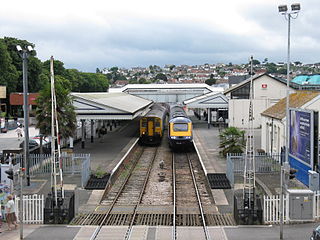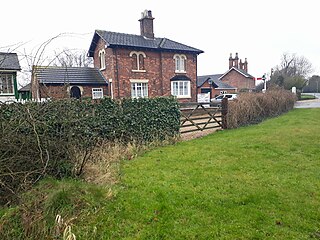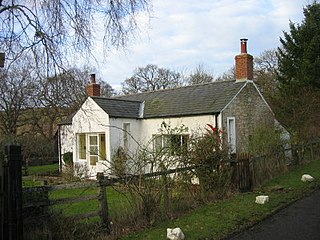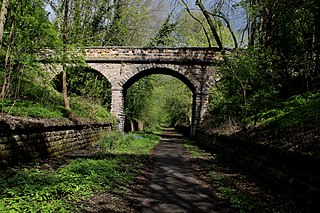
Paignton railway station serves the town and seaside resort of Paignton in Devon, England. It is 222 miles 12 chains measured from London Paddington. The station is the current terminus of the Riviera Line from Exeter and is also an interchange station between National Rail services and the preserved Dartmouth Steam Railway.

Barnoldswick railway station was the only railway station on the Midland Railway's 1-mile-64-chain (2.9 km) long Barnoldswick Branch in the West Riding of Yorkshire in England. The line left the Leeds and Bradford Extension Railway at Barnoldswick Junction 55 chains from Earby railway station. The line through the junction was on a 20-chain radius after which it converged to a single track and ran in a straight but undulating line to Barnoldswick. The passenger train that ran back and forth between Barnoldswick and Earby was known locally as the 'Barlick Spud' or 'Spudroaster'. The real reason for the name is lost in time, but the two versions that were commonly recited are that the original branch locomotive was so small it looked like a portable potato roaster used by a local vendor or that the journey time was the same as that taken to roast a potato in the locomotive's firebox.

East Ville was a railway station on the East Lincolnshire Railway which served the village of Eastville in Lincolnshire between 1848 and 1964. It originally opened as East Ville and New Leake, but was renamed in 1850. Withdrawal of passenger services took place in 1961, followed by goods facilities in 1964. The line through the station remains in use as the Poacher Line

Legbourne Road was a railway station on the East Lincolnshire Railway which served the village of Legbourne in Lincolnshire between 1848 and 1964. The station was closed to passengers in 1953, and withdrawal of goods facilities took place in 1964. The line through the station closed in 1970. The station once housed a museum containing railway memorabilia; this closed in 1998 and the building is once again a private residence.
Belses railway station served the village of Belses, Scottish Borders, Scotland from 1849 to 1969 on the Waverley Route.

Menthorpe Gate railway station was a station on the Selby to Driffield Line in North Yorkshire, England serving the village of North Duffield and the hamlets of Menthorpe and Bowthorpe. It appeared first in public timetables in 1851 and kept the "Gate" suffix when it was dropped from many other station names in 1864. In 1881, a station mistress is recorded.

Goswick railway station served the hamlet of Goswick, Northumberland, England from 1870 to 1964 on the East Coast Main Line.

Christon Bank railway station served the village of Christon Bank, Northumberland, England from 1847 to 1965 on the East Coast Main Line.
Longhirst railway station served the village of Longhirst, Morpeth, England from 1847 to 1964 on the East Coast Main Line.
Plessey railway station served the hamlet of Plessey, Northumberland, England from 1859 to 1962 on the East Coast Main Line.
Fencehouses railway station served the village of Fencehouses, Tyne and Wear, England from 1841 to 1964 on the Leamside line.

Hunwick railway station served the village of Hunwick, County Durham, England from 1857 to 1964 on the Durham to Bishop Auckland Line.

Marston Moor railway station served the village of Long Marston, North Yorkshire, England from 1848 to 1967 on the Harrogate line.

Wilstrop railway station served Wilstrop and Skipbridge, North Yorkshire, England from 1865 to 1964 on the Harrogate line.

Hopperton railway station served the village of Hopperton, North Yorkshire, England from 1848 to 1962 on the Harrogate line.

Goldsborough railway station served the village of Goldsborough, North Yorkshire, England from 1850 to 1965 on the Harrogate line. The station was over 13 miles (21 km) west of York railway station, and nearly 3 miles (4.8 km) east of Knaresborough.

Thorneyburn railway station served the village of Thorneyburn, Northumberland, England from 1861 to 1956 on the Border Counties Railway.

Thorp Arch railway station was a station in the parish of Wetherby, West Yorkshire, on the Harrogate–Church Fenton line. It opened on 10 August 1847 and served nearby Thorp Arch as well as Boston Spa. The station closed to passengers on 6 January 1964 and completely on 10 August 1964.

Newton Kyme railway station was a railway station on the former Harrogate–Church Fenton line, serving the village of Newton Kyme near Tadcaster in North Yorkshire. It handled freight and passenger traffic.
Norham railway station served the village of Norham, Northumberland, England, from 1849 to 1965 on the Kelso Branch.















